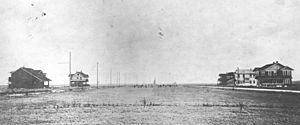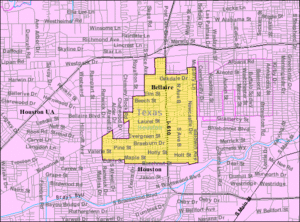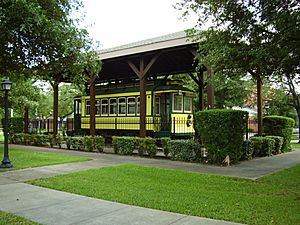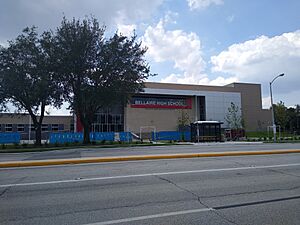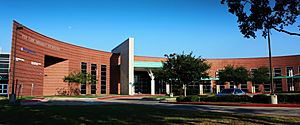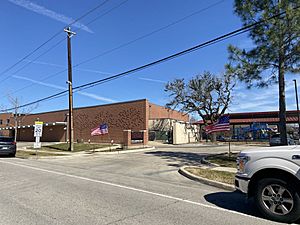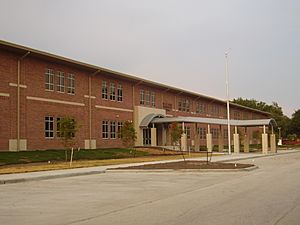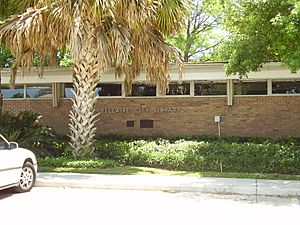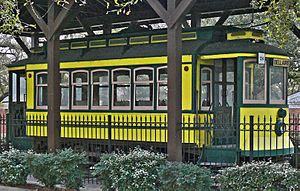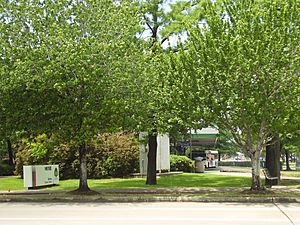Bellaire, Texas facts for kids
Quick facts for kids
City of Bellaire
|
|
|---|---|
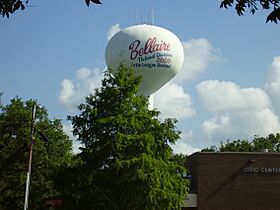
The Bellaire water tower, celebrating the city's little league team
|
|
| Country | United States |
| State | Texas |
| County | Harris |
| Incorporated | June 24, 1918 |
| Government | |
| • Type | Council-Manager |
| Area | |
| • Total | 3.60 sq mi (9.32 km2) |
| • Land | 3.60 sq mi (9.32 km2) |
| • Water | 0.00 sq mi (0.00 km2) |
| Elevation | 52 ft (16 m) |
| Population
(2020)
|
|
| • Total | 17,202 |
| • Density | 5,274.12/sq mi (2,036.44/km2) |
| Time zone | UTC-6 (CST) |
| • Summer (DST) | UTC-5 (CDT) |
| ZIP codes |
77401-77402
|
| Area codes | 281, 346, 713, 832 |
| FIPS code | 48-07300 |
| GNIS feature ID | 1330381 |
| Website | [1] |
Bellaire is a city in southwestern Harris County, Texas, United States. It's part of the larger Houston area. In 2020, about 17,202 people lived there. Bellaire is surrounded by the cities of Houston and West University Place. It's often called the "City of Homes" because it's mostly a residential area. However, it also has offices along the I-610 Loop.
Contents
Discover Bellaire's Past
How Bellaire Began
Bellaire was started in 1908 by William Wright Baldwin. He was the president of the South End Land Company. Baldwin was also a vice president of the Burlington Railroad. Bellaire was built on land that used to be part of William Marsh Rice's large ranch.
Baldwin divided about 1,000 acres of the ranch into small farms. He called these "Westmoreland Farms." Bellaire was then created in the middle of these farms. It was meant to be a place for people to live and a center for farmers to trade goods. Baldwin advertised to farmers in the Midwestern United States. He said the town was named "Bellaire," meaning "Good Air," because of its breezes. It might also be named after Bellaire, Ohio, a town on one of Baldwin's train lines.
Growing into a City
At first, there was a six-mile empty space between Houston and Bellaire. Bellaire became an official city in 1918, ten years after it was founded. About 200 people lived there at that time. Because Bellaire became a city, Houston couldn't take over its land, even though Houston was growing and adding nearby areas.
By 1940, Bellaire's population grew to 1,124. After World War II, many new houses were built, and the population quickly increased. On December 31, 1948, Houston surrounded Bellaire by adding the land around it. This stopped Bellaire from growing its land area. Bellaire stayed independent from Houston. In 1949, it adopted a new way of governing with a city council and a city manager.
By 1950, Bellaire had 10,173 residents and 3,186 houses. More houses were added in the next two years. This growth led to new schools like Bellaire High School and two elementary schools. In the 1960s, about 250 houses were taken down to build the I-610 Loop highway, which cut through the city.
Modern Bellaire and Changes
In the early 1990s, Bellaire decided to make it easier for new homes to be built. This helped the city's tax income grow. Many people started moving to Bellaire because land prices were lower than in nearby West University Place. Bellaire was seen as a good deal, with great city services and schools. The price of an average house in Bellaire went from $75,000 in 1986 to $500,000 in 2006.
In 2002, the city tried to buy Teas Nursery, a very old business, to turn it into a park. The nursery fought this plan. Later, the nursery sold some of its land for homes. In 2005, the issue was settled. Teas Nursery closed in 2010. The Rubenstein family bought the property and planned to give it to the city for a park. This park is now Evelyn's Park.
In 2005, during Hurricane Rita evacuations, a sad event happened when a bus carrying nursing home residents from Bellaire caught fire. In 2008, a tour bus with singer Emilio Navaira crashed in Bellaire. By 2008, more houses in Bellaire were selling for over $1,000,000.
In 2008, there was a community discussion about police actions in Bellaire. Mayor Cindy Siegel said the city would look into traffic stop data. The local National Association for the Advancement of Colored People (NAACP) branch worked with the city to address concerns.
In 2015, Andrew Friedberg became mayor. In August 2017, Hurricane Harvey affected the city. During the COVID-19 pandemic in Texas in 2020, Bellaire had a relatively low number of cases, possibly due to its lower population density and wealth.
Bellaire's Location and Weather
Bellaire is located at 29°42′11″N 95°28′06″W / 29.70306°N 95.46833°W. The city covers about 3.6 square miles (9.3 square kilometers) of land. It is completely surrounded by Houston, West University Place, and Southside Place.
| Climate data for Bellaire, Texas | |||||||||||||
|---|---|---|---|---|---|---|---|---|---|---|---|---|---|
| Month | Jan | Feb | Mar | Apr | May | Jun | Jul | Aug | Sep | Oct | Nov | Dec | Year |
| Mean daily maximum °F (°C) | 62 (17) |
66 (19) |
72 (22) |
79 (26) |
86 (30) |
91 (33) |
94 (34) |
94 (34) |
89 (32) |
82 (28) |
72 (22) |
64 (18) |
79 (26) |
| Mean daily minimum °F (°C) | 42 (6) |
45 (7) |
51 (11) |
58 (14) |
66 (19) |
72 (22) |
74 (23) |
74 (23) |
69 (21) |
60 (16) |
51 (11) |
43 (6) |
59 (15) |
| Average precipitation inches (mm) | 4.06 (103) |
2.98 (76) |
3.24 (82) |
3.48 (88) |
4.69 (119) |
5.51 (140) |
3.30 (84) |
4.29 (109) |
5.82 (148) |
4.03 (102) |
4.58 (116) |
3.36 (85) |
49.34 (1,252) |
| Source: Weather.com | |||||||||||||
What Bellaire Looks Like
Bellaire has larger housing lots than some nearby cities. This means houses can be bigger and still have space for a detached garage or a swimming pool. Many of the original houses were smaller, built after World War II. As land prices went up, many of these older homes were torn down to build new, larger ones.
Some parts of Bellaire, like the Carroll and Braeburn Country Club Estates subdivisions, have bigger houses on larger lots, some built in the 1950s and 1960s. Many Bellaire streets are named after trees, like "Holly," "Holt," "Maple," and "Pine."
Who Lives in Bellaire
| Race | Number | Percentage |
|---|---|---|
| White (NH) | 10,188 | 59.23% |
| Black or African American (NH) | 281 | 1.63% |
| Native American or Alaska Native (NH) | 28 | 0.16% |
| Asian (NH) | 4,072 | 23.67% |
| Pacific Islander (NH) | 9 | 0.05% |
| Some other race (NH) | 90 | 0.52% |
| Mixed/multi-racial (NH) | 704 | 4.09% |
| Hispanic or Latino | 1,830 | 10.64% |
| Total | 17,202 |
In 2020, Bellaire had 17,202 people living in 6,755 households. Many families live in Bellaire, with 44.2% of households having children under 18. The average household had 2.78 people. The median age in Bellaire was 41.6 years.
In 2019, the average household income was $201,629. Bellaire residents generally have a high life expectancy, around 87.4 years. Only about 2.3% of the population lived at or below the poverty line.
Places of Worship
Holy Ghost Church, a Roman Catholic church, is very close to Bellaire. It has services in both English and Spanish. Bellaire also has St. Mark Coptic Orthodox Church.
Bellaire's Economy
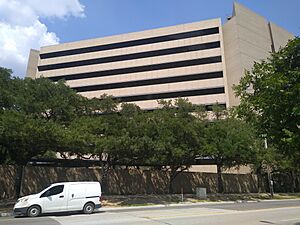
Bellaire has areas set aside for businesses and offices. You can find tall office buildings along Interstate 610. Companies like Frost Bank and AT&T Inc. have offices in Bellaire. The Houston Metropolitan Chamber helps businesses in the area. South Texas Dental also has its main offices here.
Chevron used to have a large campus in Bellaire. About 900 employees worked there in 2016. Chevron decided to move these employees to Downtown Houston and sell the building. Local school officials even thought about buying it for a new Bellaire High School.
Fun Things to Do in Bellaire
Bellaire has many parks managed by the city.
- Bellaire Zindler Park is a large park with a pool, tennis courts, a gazebo, and a jogging trail. It also has the Bellaire Recreation Center and Civic Center.
- Evergreen Park has a pool and a playground.
- Feld Park offers a softball field, playground, and tennis courts.
- Horn Field is great for sports, with baseball and soccer fields.
- Lafayette Park includes a playground and the Officer Lucy Dog Park.
- Paseo Park runs along Bellaire Boulevard and features the Bellaire Trolley.
- Pin Oak Park has baseball, soccer, and football fields, plus a jogging track.
- Russ Pitman Park is a nature area with trails and a playground.
Evelyn's Park is a newer park on the land where Teas Nursery used to be. It opened in 2017.
Bellaire hosts fun events each year, like Fourth of July parades and "snow" celebrations for Christmas.
Bellaire's Little League baseball team is well-known. In 2000, they played in the Little League World Series. The Weekley YMCA also serves Bellaire residents.
Learning in Bellaire
Public Schools
Bellaire is part of the Houston Independent School District (HISD).
- Elementary Schools: Students living inside the 610 Loop go to Paul W. Horn Academy. Those outside the loop go to either Al J. Condit Elementary School or Lovett Elementary School.
- Middle Schools: All Bellaire students are zoned to Pershing Middle School. They can also choose to attend Pin Oak Middle School, which is located in Bellaire and was named a National Blue Ribbon School in 2008.
- High School: All Bellaire students attend Bellaire High School, which is in Bellaire.
HISD also has public early childhood centers for eligible students. Condit Elementary School got a new building in 2016.
History of Bellaire Schools
Bellaire's first school opened in 1909 and later became Condit Elementary. Horn opened in 1949, Pershing in 1927, and Bellaire High School in 1955. Pin Oak Middle School opened in 2002.
In 2012, HISD opened the Mandarin Chinese Language Immersion Magnet School in the former Gordon Elementary building. This was HISD's first Chinese immersion school.
Private Schools
Bellaire has several private schools:
- Episcopal High School (grades 9–12)
- The Post Oak School (Montessori K–8)
- Veritas Christian Academy (K–8)
Other private schools close to Bellaire include Holy Ghost School and St. Vincent de Paul School (Catholic K–8 schools), Saint Agnes Academy, Strake Jesuit College Preparatory, and St. Thomas' Episcopal School.
Community Colleges
The Texas Legislature has chosen Houston Community College System (HCC) to serve the Houston ISD area, including Bellaire. HCC has campuses nearby, like the Gulfton Center and the West Loop Center.
Public Library
Bellaire has its own library, the Bellaire City Library, which opened in 1951. The Friends of the Bellaire Library is a group that helps support the library.
News and Media
The Houston Chronicle is the main regional newspaper for Bellaire. Local news is also covered by the Village News and Southwest News and the Bellaire Examiner. The Bellaire Buzz is a monthly magazine mailed to all residents. BellaireConnect.com is a community website.
Getting Around Bellaire
Bellaire is part of the Metropolitan Transit Authority of Harris County, Texas (METRO) system. You can get around by bus using several lines that serve the city. The Bellaire Transit Center is a major hub for these bus lines. There are also plans for a METRORail line, the University Line, to include a Bellaire Station in the future.
In the past, Bellaire Boulevard and a historic street car line connected Bellaire to Houston. This streetcar, nicknamed the "Toonerville Trolley," ran from 1910 to 1927. It was replaced by a bus line. In 1985, a similar streetcar was brought from Portugal to Bellaire for display.
Famous People from Bellaire
- Jon Bass
- Ezra Charles
- Bubba Crosby
- José Cruz Jr.
- Richard Linklater
- Emeka Okafor
- Dennis Quaid
- Randy Quaid
- Brent Spiner
- Jaylen Waddle
- Josh Wolf
Images for kids
See also
 In Spanish: Bellaire (Texas) para niños
In Spanish: Bellaire (Texas) para niños


